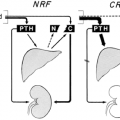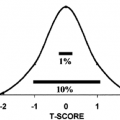MALE PUBERTY
Part of “CHAPTER 91 – PHYSIOLOGY OF PUBERTY“
PATTERN OF ONSET AND PROGRESSION
The initial physical evidence of puberty among boys is testicular growth (see Fig. 91-1B). Because seminiferous tubules make up the bulk of the testes, this change of testicular size is attributable primarily to seminiferous tubular growth. It follows an increase in circulating FSH levels with concomitant early elevation of testosterone levels. The long axis of the testis gradually
lengthens from ages 10 to 18. On average, the testis is 2.0 cm in its long axis in the boy approaching pubertal age; a testis longer than 2.5 to 3.0 cm is considered to have begun pubertal development and is present just before the 12th birthday in the average boy.50 Testicular length gradually increases to a mean adult length of 5.0 cm, which is attained between 16 and 18 years of age. Testicular volume increases from ˜2 mL at age 10 to a mean of 20 to 25 mL. Generally, testicular growth is bilaterally symmetric, although one testis may be disproportionally large. In most instances of unilateral hypertrophy, the contralateral testis is small for the stage of development and the patient has a history consistent with possible injury, such as herniorrhaphy or orchiopexy. Symmetric, fully developed testes rarely exceed 6 cm in length. In instances of true unilateral hypertrophy, the long axis of the testis may be as great as 8 cm (also see Chap. 7 and Chap. 93).
lengthens from ages 10 to 18. On average, the testis is 2.0 cm in its long axis in the boy approaching pubertal age; a testis longer than 2.5 to 3.0 cm is considered to have begun pubertal development and is present just before the 12th birthday in the average boy.50 Testicular length gradually increases to a mean adult length of 5.0 cm, which is attained between 16 and 18 years of age. Testicular volume increases from ˜2 mL at age 10 to a mean of 20 to 25 mL. Generally, testicular growth is bilaterally symmetric, although one testis may be disproportionally large. In most instances of unilateral hypertrophy, the contralateral testis is small for the stage of development and the patient has a history consistent with possible injury, such as herniorrhaphy or orchiopexy. Symmetric, fully developed testes rarely exceed 6 cm in length. In instances of true unilateral hypertrophy, the long axis of the testis may be as great as 8 cm (also see Chap. 7 and Chap. 93).
STAGING OF GENITAL SIZE AND PUBIC HAIR DEVELOPMENT
The staging of male pubertal sexual maturation is based on genital size and pubic hair development33 (Table 91-4). The average and range of circulating levels of various hormones during the stages of male development are listed in Table 91-5.2,9,18,20,35,51 Stage 2 of genital growth begins when testicular enlargement is recognizable. The criteria are a visible increase in the size of the penis, scrotum, and testes. The length of the longitudinal axis of the testes during stage 2 ranges from 2.5 to 3.2 cm. Stage 3 occurs subsequent to further growth, when the penis has increased in diameter as well as length, the scrotum is further developed, and the testes have increased in length to 3.3 to 4.0 cm. Stage 4 involves further growth of the genitalia. The penis becomes broader. The long axis of the testes reaches 4.0 to 4.5 cm. At this stage, the prostate is palpable by rectal examination. Stage 5 genitalia are within the adult range in size.
Stay updated, free articles. Join our Telegram channel

Full access? Get Clinical Tree






